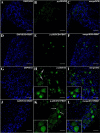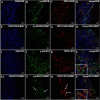Anti-hyperalgesic effects of photobiomodulation therapy (904 nm) on streptozotocin-induced diabetic neuropathy imply MAPK pathway and calcium dynamics modulation
- PMID: 36202956
- PMCID: PMC9537322
- DOI: 10.1038/s41598-022-19947-2
Anti-hyperalgesic effects of photobiomodulation therapy (904 nm) on streptozotocin-induced diabetic neuropathy imply MAPK pathway and calcium dynamics modulation
Abstract
Several recent studies have established the efficacy of photobiomodulation therapy (PBMT) in painful clinical conditions. Diabetic neuropathy (DN) can be related to activating mitogen-activated protein kinases (MAPK), such as p38, in the peripheral nerve. MAPK pathway is activated in response to extracellular stimuli, including interleukins TNF-α and IL-1β. We verified the pain relief potential of PBMT in streptozotocin (STZ)-induced diabetic neuropathic rats and its influence on the MAPK pathway regulation and calcium (Ca2+) dynamics. We then observed that PBMT applied to the L4-L5 dorsal root ganglion (DRG) region reduced the intensity of hyperalgesia, decreased TNF-α and IL-1β levels, and p38-MAPK mRNA expression in DRG of diabetic neuropathic rats. DN induced the activation of phosphorylated p38 (p-38) MAPK co-localized with TRPV1+ neurons; PBMT partially prevented p-38 activation. DN was related to an increase of p38-MAPK expression due to proinflammatory interleukins, and the PBMT (904 nm) treatment counteracted this condition. Also, the sensitization of DRG neurons by the hyperglycemic condition demonstrated during the Ca2+ dynamics was reduced by PBMT, contributing to its anti-hyperalgesic effects.
© 2022. The Author(s).
Conflict of interest statement
The authors declare no competing interests.
Figures









Similar articles
-
Raman spectroscopy of dorsal root ganglia from streptozotocin-induced diabetic neuropathic rats submitted to photobiomodulation therapy.J Biophotonics. 2019 Nov;12(11):e201900135. doi: 10.1002/jbio.201900135. Epub 2019 Jul 2. J Biophotonics. 2019. PMID: 31265175
-
[Tetrahydropalmatine alleviated diabetic neuropathic pain by inhibiting activation of microglia via p38 MAPK signaling pathway].Zhongguo Zhong Yao Za Zhi. 2022 May;47(9):2533-2540. doi: 10.19540/j.cnki.cjcmm.20220119.702. Zhongguo Zhong Yao Za Zhi. 2022. PMID: 35531701 Chinese.
-
Long Non-coding RNA BC168687 is Involved in TRPV1-mediated Diabetic Neuropathic Pain in Rats.Neuroscience. 2018 Mar 15;374:214-222. doi: 10.1016/j.neuroscience.2018.01.049. Epub 2018 Feb 5. Neuroscience. 2018. PMID: 29421435
-
Direct role of streptozotocin in inducing thermal hyperalgesia by enhanced expression of transient receptor potential vanilloid 1 in sensory neurons.Mol Pharmacol. 2008 Mar;73(3):995-1004. doi: 10.1124/mol.107.041707. Epub 2007 Dec 18. Mol Pharmacol. 2008. PMID: 18089839
-
P2Y12 shRNA treatment decreases SGC activation to relieve diabetic neuropathic pain in type 2 diabetes mellitus rats.J Cell Physiol. 2018 Dec;233(12):9620-9628. doi: 10.1002/jcp.26867. Epub 2018 Jun 26. J Cell Physiol. 2018. PMID: 29943819
Cited by
-
Photobiomodulation at molecular, cellular, and systemic levels.Lasers Med Sci. 2023 Jun 13;38(1):136. doi: 10.1007/s10103-023-03801-6. Lasers Med Sci. 2023. PMID: 37310556 Review.
-
Diabetes in spotlight: current knowledge and perspectives of photobiomodulation utilization.Front Endocrinol (Lausanne). 2024 Mar 19;15:1303638. doi: 10.3389/fendo.2024.1303638. eCollection 2024. Front Endocrinol (Lausanne). 2024. PMID: 38567306 Free PMC article. Review.
-
Photobiomodulation mitigates Bothrops jararacussu venom-induced damage in myoblast cells by enhancing myogenic factors and reducing cytokine production.PLoS Negl Trop Dis. 2024 May 30;18(5):e0012227. doi: 10.1371/journal.pntd.0012227. eCollection 2024 May. PLoS Negl Trop Dis. 2024. PMID: 38814992 Free PMC article.
-
Diabetic peripheral neuropathy: pathogenetic mechanisms and treatment.Front Endocrinol (Lausanne). 2024 Jan 9;14:1265372. doi: 10.3389/fendo.2023.1265372. eCollection 2023. Front Endocrinol (Lausanne). 2024. PMID: 38264279 Free PMC article. Review.
-
Photobiomodulation for diabetes and its complications: a review of general presentation, mechanisms and efficacy.Ann Med. 2024 Dec;56(1):2433684. doi: 10.1080/07853890.2024.2433684. Epub 2024 Nov 28. Ann Med. 2024. PMID: 39607829 Free PMC article. Review.
References
Publication types
MeSH terms
Substances
LinkOut - more resources
Full Text Sources
Medical
Miscellaneous

